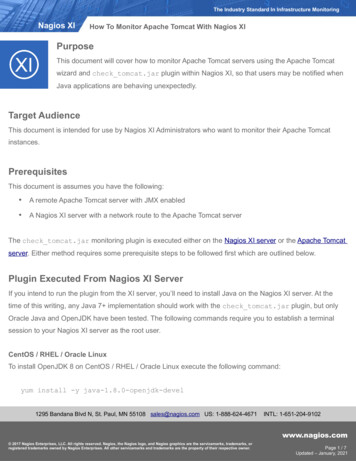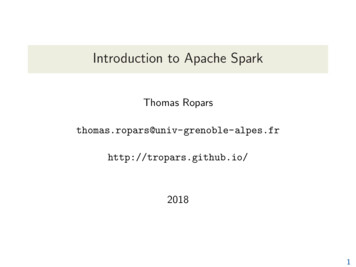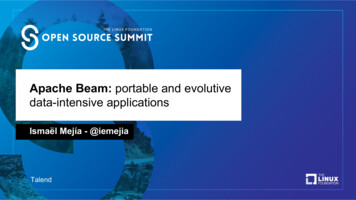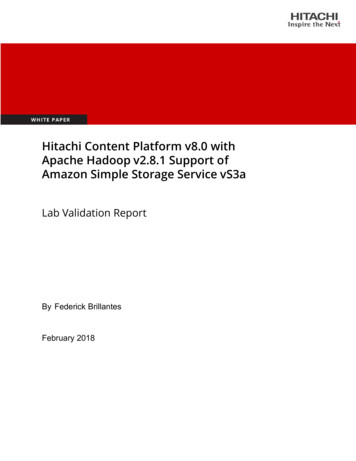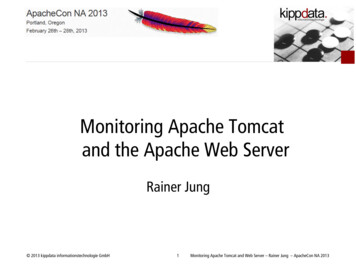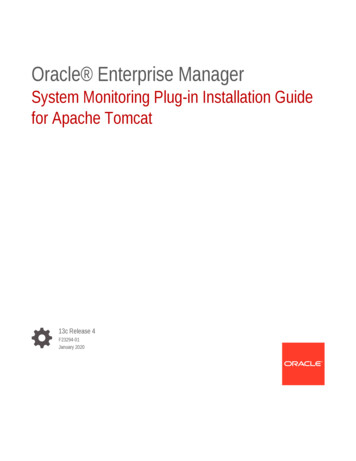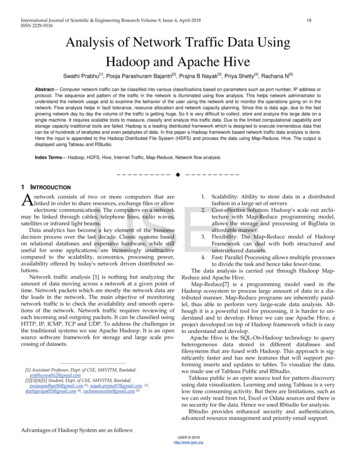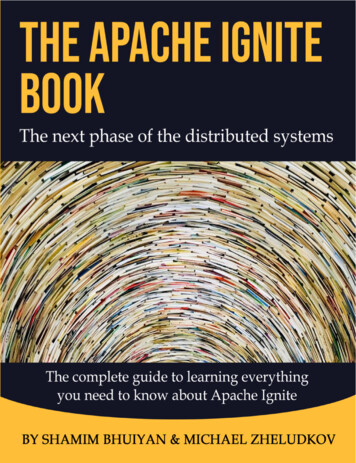
Transcription
The Apache Ignite bookThe next phase of the distributed systemsShamim Bhuiyan and Michael ZheludkovThis book is for sale at http://leanpub.com/ignitebookThis version was published on 2020-01-13ISBN 978-0-359-43937-9This is a Leanpub book. Leanpub empowers authors and publishers with the LeanPublishing process. Lean Publishing is the act of publishing an in-progress ebook usinglightweight tools and many iterations to get reader feedback, pivot until you have the rightbook and build traction once you do. 2018 - 2020 Shamim Bhuiyan
Tweet This Book!Please help Shamim Bhuiyan and Michael Zheludkov by spreading the word about thisbook on Twitter!The suggested tweet for this book is:Just purchased ”The Apache Ignite Book” https://leanpub.com/ignitebook by @shamim ru#ApacheIgnite #IMDG #NoSQL #BigData #caching
To my Mother & Brothers, thank you for your unconditional love.
ContentsPreface . . . . . . . . . . .What this book coversCode Samples . . . . .Readership . . . . . . .Conventions . . . . . .Reader feedback . . .iiiiiiiiiiivAbout the authors . . . . . . . . . . . . . . . . . . . . . . . . . . . . . . . . . . . . . . .vChapter 4. Architecture deep dive . . . . . . . . . . . . . . . . . . .Understanding the cluster topology: shared-nothing architectureClient and server node . . . . . . . . . . . . . . . . . . . . . .Embedded with the application . . . . . . . . . . . . . . . . .Client and the server nodes in the same host . . . . . . . . .Running multiple nodes within single JVM . . . . . . . . . .Real cluster topology . . . . . . . . . . . . . . . . . . . . . . .Data partitioning in Ignite . . . . . . . . . . . . . . . . . . . . . . .Understanding data distribution: DHT . . . . . . . . . . . . .Rendezvous hashing . . . . . . . . . . . . . . . . . . . . . . . .Durable memory architecture . . . . . . . . . . . . . . . . . . . . .Page . . . . . . . . . . . . . . . . . . . . . . . . . . . . . . . . .Data Page . . . . . . . . . . . . . . . . . . . . . . . . . . . . . .Index pages and B trees . . . . . . . . . . . . . . . . . . . . .Segments . . . . . . . . . . . . . . . . . . . . . . . . . . . . . .Region . . . . . . . . . . . . . . . . . . . . . . . . . . . . . . . .Ignite read/write path . . . . . . . . . . . . . . . . . . . . . . . . .Write-Ahead-Log (WAL) . . . . . . . . . . . . . . . . . . . . . . .Baseline topology . . . . . . . . . . . . . . . . . . . . . . . . . . . .Automatic cluster activation . . . . . . . . . . . . . . . . . . .1125667891316171819202123263236
CONTENTSSplit-brain protection . . . . . . . . . . . . . . . . . . . . . . . . . . . . . . . . .Fast rebalancing and it’s pitfalls . . . . . . . . . . . . . . . . . . . . . . . . . . .Chapter 5. Intelligent cachingSmart caching . . . . . . . .Caching best practicesDesign patterns . . . .Basic terms . . . . . . .Database caching . . . . . .414344454646Chapter 6. Database . . . . . . . . . . . . . . . . . . . . . . . . . . . . . . . . . . . . . .How SQL queries works in Ignite . . . . . . . . . . . . . . . . . . . . . . . . . .Spring Data integration . . . . . . . . . . . . . . . . . . . . . . . . . . . . . . . . . .505064Chapter 8. Streaming and complex event processing . . . . . . . . . . . . . . . . . .Kafka Streamer . . . . . . . . . . . . . . . . . . . . . . . . . . . . . . . . . . . . . . .IgniteSourceConnector . . . . . . . . . . . . . . . . . . . . . . . . . . . . . . . .666969Chapter 10. Management and monitoringManaging Ignite cluster . . . . . . . . .Monitoring Ignite cluster . . . . . . . .VisualVM . . . . . . . . . . . . . . .Grafana . . . . . . . . . . . . . . . .7273737579.3840.
PrefaceApache Ignite is one of the most widely used open source memory-centric distributed,caching, and processing platform. This allows the users to use the platform as an inmemory computing framework or a full functional persistence data stores with SQL andACID transaction support. On the other hand, Apache Ignite can be used for acceleratingexisting Relational and NoSQL databases, processing events & streaming data or developingMicroservices in fault-tolerant fashion.This book addressed anyone interested in learning in-memory computing and distributeddatabase. This book intends to provide someone with little to no experience of ApacheIgnite with an opportunity to learn how to use this platform effectively from scratch takinga practical hands-on approach to learning.What this book coversChapter 1. Introduction: gives an overview of the trends that have made in-memorycomputing such important technology today. By the end of this chapter, you will have aclear idea of what Apache Ignite is and why use Apache Ignite instead of others frameworkslike HazelCast, Ehcache?Chapter 2. Getting started with Apache Ignite: is about getting excited. This chapter walksyou through the initial setup of an Ignite database and running of some sample application.You will implement your first Ignite application to read and write entries from the Cacheat the end of the chapter. Also, you will learn how to install and configure an SQL IDE torun SQL queries against Ignite caches and use Apache Ignite Thin client to working with theIgnite database.Chapter 3. Apache Ignite use cases: discusses various design decisions and use cases whereIgnite can be deployed. These use cases detailed and explained through the rest of the book.Chapter 4. Architecture deep dive: covers Ignite’s internal plumbing. This chapter has a lotof useful design concepts if you have never worked with a distributed system. This chapterintroduces Ignite shared nothing architecture, cluster topology, distributed hashing, Ignitereplication strategy and durable memory architecture. It is a theoretical chapter; you mayskip (not recommended) it and come back later.
PrefaceiiChapter 5. Intelligent caching: presents Ignite smart caching capabilities, Memoization,and Web-session clustering. This chapter covers developments and techniques to improvethe performance of your existing web applications without changing any code.Chapter 6. Database: guides you through the Ignite database features. This massive chapterexplores: Ignite tables and index configurations, different Ignite queries, how SQL worksunder the cover, collocated/Non-collocated distributed joins, Spring data integration, usingIgnite with JPA and Ignite native persistence. This chapter is for you if you are planning touse Ignite as a database.Chapter 7. Distributed computing: focuses on more advanced Ignite features such asdistributed computing and how Ignite can help you develop Micro-service like application,which will be performed in parallel fashion to gain high performance, low latency, and linearscalability. You will learn about Ignite inline MapReduce & ForkJoin, distributed closureexecution, continuous mapping for data processing across multiple nodes in the cluster.Chapter 8. Streaming and complex event processing: takes the next step and goes beyondusing Apache Ignite to solve complex real-time event processing problem. This chaptercovers how Ignite can be used easily with other Big data technologies such as Kafka, flume,storm, and camel to solve various business problems. We will guide you through withcomplete examples for developing real-time data processing on Apache Ignite.Chapter 9. Accelerating Big data computing: is a full chapter about how to use ApacheSpark Dataframe and RDD for processing massive datasets. We detailed by examples of howto share the application states in memory across multiple Spark jobs by using Ignite.Chapter 10. Management and monitoring: explain the various tools that you can useto monitor and manage the Ignite cluster. For instance, configuring Zookeeper discovery,scaling up a cluster with Baseline topology. We provide a complete example of using Grafanafor monitoring Ignite cluster at the end of this chapter.Code SamplesAll code samples, scripts, and more in-depth examples can be found on the -apache-ignite-book
iiiPrefaceReadershipThe target audiences of this book are IT architect, team leaders or programmer withminimum programming knowledge. No excessive knowledge is required, though it wouldbe good to be familiar with Java, Spring framework and tools like Maven. The book is alsouseful for any reader, who already familiar with Oracle Coherence, Hazelcast, Infinispan orMemcached.ConventionsThe following typographical conventions are used in this book:Italic and Bold indicates new terms, important words, URL’s, filenames, and file extensions.A block code is set as follows:Listing 1.1public class MySuperExtractor implements StreamSingleTupleExtractor SinkRecord, String, S\tring {@Override public Map.Entry String, String extract(SinkRecord msg) {String[] parts ((String)msg.value()).split(" ");return new AbstractMap.SimpleEntry String, String (parts[1], parts[2] ":" parts[3]);}}Any command-line input or output is written as follows:[2018-09-30 15:39:04,479] INFO Kafka version : 2.0.0 8-09-30 15:39:04,479] INFO Kafka commitId : 3402a8361b734732 8-09-30 15:39:04,480] INFO [KafkaServer id 0] started (kafka.server.KafkaServer)TipThis icon signifies a tip, suggestion.
ivPrefaceWarningThis icon indicates a warning or caution.InfoThis icon signifies general note.Reader feedbackWe would like to hear your comment such as what you think, like or dislike about the contentof the book. Your feedback will help us to write a better book and help others to clear all theconcepts. To submit your feedback, please use the the feedback link².²https://leanpub.com/ignitebook/email author/new
About the authorsShamim Bhuiyan is currently working as an Enterprise architect; where he’s responsible fordesigning and building out highly scalable, and high-load middleware solutions. He receivedhis Ph.D. in Computer Science from the University of Vladimir, Russia in 2007. He has beenin the IT field for over 18 years and is specialized in Middleware solutions, Big Data andData science. Also, he is a former SOA solution designer, speaker, and Big data evangelist.Actively participates in the development and designing of high-performance software forIT, telecommunication and the banking industry. In spare times, he usually writes the blogfrommyworkshop³ and shares ideas with others.Michael Zheludkov is a senior programmer at AT Consulting. He graduated from the Bauman Moscow State Technical University in 2002. Lecturer at BMSTU since 2013, deliveringcourse Parallel programming and distributed systems.³http://frommyworkshop.blogspot.ru/
Chapter 4. Architecture deep diveApache Ignite is an open-source memory-centric distributed database, caching and computing platform. It was designed as an in-memory data grid for developing a high-performancesoftware system from the beginning. So its core architecture design is slightly different fromthat of the traditional NoSQL databases, able to simplify the building of modern applicationswith a flexible data model and simpler high availability and high scalability.To understand how to properly design an application with any databases or framework,you must first understand the architecture of the database or framework itself. By getting abetter idea of the system, you can solve different problems in your enterprise architecturelandscape, can select a comprehensive database or framework that is appropriate for yourapplication and can get maximum benefits from the system. This chapter gives you a look atthe Apache Ignite architecture and core components to help you figure out the key reasonsbehind Ignite’s success over other platforms.Understanding the cluster topology:shared-nothing architectureApache Ignite is a grid technology, and its design implies that the entire system is bothinherently available and massively scalable. Grid computing is a technology in which weutilize the resources of many computers (commodity, on-premise, VM, etc.) in a networktowards solving a single computing problem in parallel fashion.Note that there is often some confusion about the difference between grid and cluster.Grid computing is very similar to cluster computing, the big difference being that clustercomputing consists of homogeneous resources, while grids are heterogeneous. Computersthat are part of a grid can run different operating systems and have different hardware,whereas cluster computers all have the same hardware and OS. A grid can make use of sparecomputing power on a desktop computer, while the machines in a cluster are dedicated toworking as a single unit and nothing else. Throughout this book, we use the terms grid andcluster interchangeably.Apache Ignite also provides a shared-nothing architecture⁴ where multiple identical ng architecture
Chapter 4. Architecture deep dive2form a cluster with no single master or coordinator. All nodes in a shared-nothing cluster areidentical and run the exact same process. In the Ignite grid, nodes can be added or removednondisruptively to increase (or decrease) the amount of RAM available. Ignite internodecommunication allows all nodes to receive updates quickly without having any mastercoordinator. Nodes communicate using peer-to-peer message passing. The Apache Ignitegrid is sufficiently resilient, allowing the nondisruptive automated detection and recoveryof a single node or multiple nodes.On the most fundamental level, all nodes in the Ignite cluster fall into one of two categories:client and server. There is a big difference between the two types of nodes, and they can bedeployed in different ways. In the rest of this section, we will talk about the topology of theIgnite grid and how it can be deployed in real life.Client and server nodeAn Ignite node is a single Ignite process running in a JVM. Apache Ignite nodes have anoptional notion of client and server nodes as we mentioned before. Often, an Ignite clientnode also addresses as a native client node. Both client and server nodes are part of Ignite’sphysical grid and are interconnected with each other. The client and server nodes have thefollowing characteristics.NodeServerClientDescription1. Acts as a container for storing data and computing. A server node contains data,participates in caching, computing and streaming. 2. Generally starts as a standaloneJava process.1. Acts as an entry point to run operations like put/get into the cache. 2. Can storeportions of data in the near cache, which is a smaller local cache that stores mostrecently and most frequently accessed data. 3. It is also used to deploy compute andservice tasks to the server nodes and can participate in computation tasks (optional). 4.Usually embedded with the application code.TipYou often encounter the term data node in the Ignite documentation. The termsdata node and server node refer to the same thing and are used interchangeably.All nodes in the Ignite grid start as server nodes by default, and client nodes need to beexplicitly enabled. You can imagine the Ignite client node as a thick client (also called a fatclient, e.g., Oracle OCI8). Whenever a client node connects to the Ignite grid or cluster, it is
Chapter 4. Architecture deep dive3aware of the grid topology (data partitions for each node) and is able to send a request to theparticular node to retrieve data. You can configure an Ignite node to be either a client or aserver via a Spring or Java configuration, as shown below.Spring configuration:Listing 4.1 bean class on" . !-- Enable client mode. -- property name "clientMode" value "true"/ . /bean Java configuration:Listing 4.2IgniteConfiguration cfg1 new IgniteConfiguration();cfg1.setGridName("name1");// Enable client mode.cfg1.setClientMode(true);// Start Ignite node in client modeIgnite ignite1 Ignition.start(cfg1);Here is also a special type of logical node called a compute node in the Ignite cluster. Acompute node is the node that usually participates in computing business logic. Basically, aserver node that contains data is also used to execute computing tasks.
4Chapter 4. Architecture deep diveFigure 4.2However, an Apache Ignite client node can also participate in computing tasks optionally.The concept might seem complicated at first glance, but let’s try to clarify it.Server nodes or Data nodes always stores data and participating in any computing task.On the other hand, the Client node can manipulate the server caches, store local data andoptionally participate in computing tasks. Usually, client nodes are only used to put orretrieve data from the caches.Why should you want to run any computing task on client nodes? In some cases (for instancehigh volume transactions in the server nodes), you do not want to execute any job orcomputing task on the server nodes. In such a case, you can choose to perform jobs onlyon client’s nodes by creating a cluster group. This way, you can separate the server node(data node) from the nodes that are particular uses for computing in the same grid.A cluster group is a logical unit of a few nodes (server or client node) that group together ina cluster to perform some work. Within a cluster group, you can limit job execution, servicedeployment, streaming and other tasks to run only within a cluster group. You can createa cluster group based on any predicate. For instance, you can create a cluster group froma group of nodes, where all the nodes are responsible for caching data for a cache namedtestCache. It’s enough for now, and we will explore this distinction later in the subsequentsection of this chapter.Ignite nodes can be divided into two major groups from the deployment point of view:1. Embedded with the application.2. Standalone server node.
5Chapter 4. Architecture deep diveEmbedded with the applicationApache Ignite as a Java application can be deployed embedded with other applications. Itmeans that Ignite nodes will be runs on the same JVM that uses the application. Ignite nodecan be embedded with any Java web application artifact like WAR or EAR running on anyapplication server or with any standalone Java application. Our HelloIgnite Java applicationfrom chapter 2 is a perfect example of embedded Ignite server. We start our Ignite server asa part of the Spring application running on the same JVM and joins with other nodes of thegrids in this example. In this approach, the life cycle of the Ignite node is tightly bound withthe life cycle of the entire application itself. Ignite node will also shut down if the applicationdies or is taken down. This topology is shown in figure 4.3.Figure 4.3If you change the IgniteConfiguration.setClientMode property to false, and rerun theHelloIgnite application, you should see the following:Figure 4.4HelloIgnite Java application run and joins to the cluster as a server node. The applicationexists from the Ignite grid after inserting a few datasets. Another excellent example ofusing Ignite node as an embedded mode are implementing web session clustering. In this
6Chapter 4. Architecture deep diveapproach, you usually configure (web.xml file) your web application to start an Ignite nodein embedded mode. When multiple application server instances are running, all embeddedIgnite nodes connect with each other and forming an Ignite grid. Please see the chapter 5Intelligent caching for more details of using web session clustering.Client and the server nodes in the same hostThis is one of the typical cases when Ignite client and server nodes are running on differentJVM in the same host. You can execute Ignite client and server nodes in separate containerssuch as Docker or OpenVZ if you are using container technology for running JVM. Bothcontainers can be located in the same single host.Figure 4.5The container isolates the resources (CPU, RAM, Network interface) and the JVM only usesisolated resources assigned to this container. Moreover, the Ignite client and server node canbe deployed in the separate JVM in the single host without containers, where they all usethe shared resourced assigned to this host machine. Host machine could be any on-premise,virtual machine or Kubernates pods.Running multiple nodes within single JVMIt is possible to start multiple nodes from within a single JVM. This approach is very popularfor unit testing among developers. Ignite nodes running on the same JVM connects with
7Chapter 4. Architecture deep diveeach other and forming an Ignite grid.Figure 4.6One of the easiest ways to run a few nodes within a single JVM is by executing the followingcode::Listing 4.3IgniteConfiguration cfg1 new e ignite1 Ignition.start(cfg1);IgniteConfiguration cfg2 new e ignite2 Ignition.start(cfg2);TipSuch a configuration is only intended for developing process and not recommended for production use.Real cluster topologyIn this approach Ignite client and server nodes are running on different hosts. These arethe most common way to deploy a large-scale Ignite cluster for production use because itprovides greater flexibilities in term of cluster technics. Individual Ignite server node can betaken down or restarted without any impact to the overall cluster.
8Chapter 4. Architecture deep diveFigure 4.6.1Such a cluster can be quickly deployed in and maintained by the kubernates⁵ which an opensource system for automating deployment, scaling, and management of the containerizedapplication. VMWare⁶ is another common cluster management system rapidly used for theIgnite cluster.Data partitioning in IgniteData partitioning⁷ is one of the fundamental parts of any distributed database despite itsstorage mechanism. Data partitioning and distribution technics are capable of handling largeamounts of data across multiple data centers. Also, these technics allow a database systemto become highly available because data has been spread across the cluster.Traditionally, it has been difficult to make a database highly available and scalable, especiallythe relational database systems that have dominated the last couple of decades. Thesesystems are most often designed to run on a single large machine, making it challengingto scale out to multiple machines.At the very high level, there are two styles of data distribution models en.wikipedia.org/wiki/Partition (database)
9Chapter 4. Architecture deep dive1. Sharding: it’s sometimes called horizontal partitioning. Sharding distributes differentdata across multiple servers, so each server act as a single source for a subset of data.Shards are called partitions in Ignite.2. Replication: replication copies data across multiple servers, so each portion of datacan be found in multiple places. Replicating each partition can reduce the chance of asingle partition failure and improves the availability of the data.TipThere are also two types of partitions available in partitions strategy: verticalpartitioning and functional partition. A detailed description of these partitioningstrategies is out of the scope of this book.Usually, there are several algorithms uses for distributing data across the cluster, a hashingalgorithm is one of them. We will cover the Ignite data distribution strategy in this section,which will build a deeper understanding of how Ignite manages data across the cluster.Understanding data distribution: DHTAs you read in the previous section, Ignite shards are called partitions. Partitions are memorysegments that can contain a large volume of a dataset, depends on the capacity of the RAMof your system. Partition helps you to spread the load over more nodes, which reducescontention and improves performance. You can scale out the Ignite cluster by adding morepartitions that run on different server nodes. The next figure shows an overview of thehorizontal partitioning or sharding.Figure 4.7
Chapter 4. Architecture deep dive10In the above example, the client profile’s data are divided into partitions based on the clientId key. Each partition holds the data for a specified range of partition key, in our case, it’s therange of the client ID key. Note that, partitions are shown here for the descriptive purpose.Usually, the partitions are not distributed in any order but are distributed randomly.Distributed Hash Table⁸ or DHT is one of the fundamental algorithms used in the distributedscalable system for partitioning data across the cluster. DHT is often used in web caching,P2P system, and distributed database. The first step to understand the DHT is Hash Tables.Hashtable⁹ needs key, value, and one hash function, where hash function maps the key to alocation (slot) where the value is located. According to this schema, we apply a hash functionto some key attribute of the entity we are storing that becomes the partition number. Forinstance, if we have four Ignite nodes and 100 clients (assume that client Id is a numericvalue), then we can apply the hash function hash (Client Id) % 4, which will return the nodenumber where we can store or retrieve the data. Let’s begin with some basic details of theHashtable.The idea behind the Hashtable is straightforward. For each element we insert, we have tohave calculated the slot (technically, each position of the hash table is called slot) numberof the element into the array, where we would like to put it. Once we need to retrieve theelement from the array, we recalculate its slot again and returns it’s as a single operation(something like return array [calculated index or slot]). That’s why it has O(1)¹⁰ timecomplexity. In short, O(1) means that the operation takes a certain (constant) amount oftimes, like 10 nanoseconds or 2 milliseconds. The process of calculating unique slot of eachelement is called Hashing and the algorithm how it’s done called Hash function.In a typical Hash table design, the Hash function result is divided by the number of arrayslots and the remainder of the division becomes the slot number of the array. So, the indexor slot into the array can be calculated by hash(o) % n, where o is the object or key, and n is thetotal number of slots into the array. Consider the following illustration below as an exampleof the hash table.⁸https://en.wikipedia.org/wiki/Distributed hash table⁹https://en.wikipedia.org/wiki/Hash table¹⁰https://en.wikipedia.org/wiki/Big O notation
11Chapter 4. Architecture deep diveFigure 4.8The value on the left represents keys in the preceding diagram, which are being hashed bythe hash function for producing the slot where the value is stored. Based on the hash valuecomputed, all the items placed in respective slots. Also, we can look up the client profile ofa given client Id by calculating its hash and then accessing the resulting slot into the array.InfoImplementation of the Hash tables has some memory overhead. Hash tables needa lot of memory to accommodate the entire. Even if most of the table is empty,we need to allocate memory for the entire table. Often, this called a time-spacetradeoff, and hashing gives the best performance for searching data at the expanseof memory.Hash table is well suited for storing data set allocated in one machine. However, when youhave to accommodate a large number of keys, for instance, millions and millions of keys,DHT comes into play. A DHT is merely a key-value store distributed across many nodes ina cluster. You have to divide the keys into subsets of keys and map those keys to a bucket.Each bucket will reside in a sperate node. You can assume a bucket as a sperate hash table.In one word, using buckets to distribute the key-value pairs is DHT.Another key objective of the hash function in a DHT is to map a key to the node that owns it,such that a request can be made to the correct node. Therefore, there are two hash functionsfor looking up the value of the key across the cluster in DHT. The first hash function willsearch for the appropriate bucket maps to the key, and the second hash function will returnthe slot number of the value for the key located in the node. We can visualize the schema asshown in figure 4.9.
12Chapter 4. Architecture deep diveFigure 4.9To illustrate this, we modified our previous hash table to store pointers to the bucket insteadof values. If we have three buckets as shown in the preceding example, then key 1 shouldgo to the bucket 1, key 2 will go to bucket 2 and so on. Therefore, we have to need one morehash function to find out the actual value of the key-value pair inside a particular bucket.HashFucntion2 is the second hash function for looking up the actual key-value pair from thebucket in this case.Table named Buckets on the left-hand side in figure 4.9 sometimes called partition table.This tables stores the partition IDs and the node associated to that partition. The functionof this table is to make all members of the entire cluster aware of this information, makingsure that all members know where the data is.The fundamental problem of DHT is that it ef
Preface Apache Ignite is one of the most widely used open source memory-centric distributed, caching, and processing plat



